Pointed arch
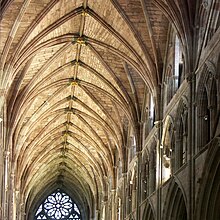
Apointed arch,ogivalarch,orGothic archis anarchwith a pointedcrownmeet at an angle at the top of the arch.[1]Also known as atwo-centred arch,its form is derived from the intersection of two circles.[2]This architectural element was particularly important inGothic architecture.The earliest use of a pointed arch dates back tobronze-ageNippur.As a structural feature, it was first used in easternChristian architecture,Byzantine architectureandSasanian architecture,but in the 12th century it came into use in France and England as an important structural element, in combination with other elements, such as therib vaultand later theflying buttress.These allowed the construction of cathedrals, palaces and other buildings with dramatically greater height and larger windows which filled them with light.[3]
Early arches[edit]
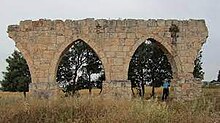
Crude arches pointed in shape have been discovered from the Bronze Age site ofNippurdated earlier than 2700 BC. The palace of Nineveh also has pointed arched drains but they have no true keystone.[4]There are many otherGreekexamples,late RomanandSassanianexamples, mostly evidenced in earlychurch buildinginSyriaandMesopotamia,but also in engineering works such as theByzantineKaramagara Bridge,with a pointed arch of 17 m span, making "the pre-Muslim origins of pointed architecture an unassailable contention".[5]
The clearest surviving example of pre-islamic pointed archs are the two pointed archs of Chytroi-Constantia Aqueduct in Cyprus dating back to the 7th century CE.[6]
Pointed arches – Islamic architecture[edit]
The pointed arch became an early feature of architecture in theIslamic world.It appeared in earlyIslamic architecture,including in bothUmayyad architectureandAbbasid architecture(late 7th to 9th centuries).[7][8]The most advanced form of pointed arch in Islamic architecture was thefour-centred arch,which appeared in the architecture of theAbbasids.Early examples include the portals of the Qubbat al-Sulaiybiyya, an octagonal pavilion, and theQasr al-'Ashiqpalace, both atSamarra,built by the Abbasid caliphs in the 9th century for their new capital.[8]It later appeared inFatimid architecturein Egypt[9]and became characteristic of the architecture ofPersianatecultures, includingPersian architecture,[10]the architecture of theTimurid Empire,[11]andIndo-Islamic architecture.[12][13][14]
-
RestoredAbbasid architecturearches of the city gates ofSamarra(9th century)
-
Central prayer niche in theMosque of Ibn Tulunin Cairo (876–879 CE)
-
Bibi-Khanym Mosque,Samarkand,Uzbekistan(1399–1404)
-
TheEurymedon Bridgein Turkey, originally built by the Romans and rebuilt with a pointed arch in the 13th century by theSeljuk Turkish Sultan
-
Sheikh Lotfollah Mosque,IsfahanIran (1603–1619)
The evolution of the pointed arch in Islamic architecture was associated with increases between the centers of the circles forming the two sides of the arch (making the arch less "blunt" and more "sharp" ), from1⁄10of thespaninQusayr 'Amra(712-715 AD), to1⁄6inHammam as-Sarah(725-730), to1⁄5inQasr Al-Mshatta(744), and finally to1⁄3inFustat(861-862).[15]
The appearance of the pointed arch in EuropeanRomanesque architectureduring the second half of the 11th century, for example atCluny Abbey,is ascribed to the Islamic influence.[16]Some researchers followViollet-le-Ducin acknowledging the spread of Arabic architecture forms through Italy, Spain and France, yet suggesting an independent invention of the pointed shape in some cases. The change was supposedly driven by the observations of the collapses of semicircular arches, with thecrownmoving down andhaunchesout. In this interpretation, the pointed arch was an attempt to strengthen the semicircular arch against a collapse by moving the crown up and haunches in.[15]
Gothic architecture – pointed arches and rib vaulting[edit]
The reduction of thrust on supports that a pointed arch provided, as compared to a semicircular one with the same load and span, was quickly recognized by medieval European builders. They achieved this at first through experimentation, but technical literature dating to the Renaissance indicates that formulas for determining thrust may have been in use during the medieval period.[15]
-
Thirteenth-century illustration byVillard de Honnecourtof how different pointed arches can be made from a single curve of the compass. FromEugène Viollet-le-Duc""Dictionnaire raisonné de l’architecture française du XIe au XVIe siècle "'
-
Gothic pointed windows, colonnades and vaults at theAbbey of Saint-Denis,Paris, drawn byEugène Viollet-le-Duc
-
The dynamics of a rib vault, with outward and downward pressure from ribs balanced by columns and buttresses. The pieces can stand by themselves, without cement. (National Museum of French Monuments, Paris)
-
An early sexpartite rib vault drawn byEugène Viollet-le-Duc
-
Rib vaults ofDurham Cathedral(1135–1490)
-
Choir ofLessay Abbeyin Normandy (1064–1178)
-
Vaulted ceiling ofCefalù Cathedralin Sicily (1131–1240)
-
Chapel of Saint Firmin inBasilica of Saint-Denis(1140–1144)
-
Lady Chapel ofSalisbury Cathedral(1220–1258)
-
Choir ofBeauvais Cathedral(begun 1225) (48.5 meters (159 ft) high
Rib vaults[edit]
In the 12th century, architects in Sicily, England and France discovered a new use for the pointed arch. They began using the pointed arch to create therib vault,which they used to cover the naves of abbeys and cathedrals. One of the first Gothic rib vaults was built atDurham Cathedralin England (1135–1490).[3]Others appeared in the deambulatory of theAbbey of Saint Denisin Paris (1140–1144),Lessay Abbeyin Normandy (1064–1178),Cefalù Cathedralin Sicily, (1131–1240). and the Cathedral ofNotre-Dame de Paris.
The rib vault quickly replaced theRomanesquebarrel vaultin the construction of cathedrals, palaces, and other large structures. In a barrel vault, theround archover the nave pressed down directly onto the walls, which had to be very thick, with few windows, to support the weight. In the rib vault, the thin stone ribs of the pointed arches distributed the weight outwards and downwards to the rows of pillars below. The result was that the walls could be thinner and higher, and they could have large windows between the columns. With the addition of theflying buttress,the weight could be supported by curving columns outside the building, which meant that the Cathedrals could be even taller, with immense stained glass windows.[17]
In the earliest type of Gothic rib vault, thesexpartite vault,the vault had a transversal pointed arch, and was divided by the ribs into six compartments. It could only cross a limited amount of space, and required a system of alternating columns and pillars. This type was used inSens CathedralandNotre-Dame de Paris.A new version was soon introduced, which reduced the number of compartments from six to four, distributed the weight equally to four pillars, eliminating the need for alternating columns and pillars, and allowed the vault to span a wider space. This quadripartite vault was used atAmiens Cathedral,Chartres Cathedral,andReims Cathedral,and gave these structures unprecedented height.[18]
Portals[edit]
Portals of Cathedrals in the Gothic period were usually in the form of a pointed arch, surrounded by sculpture, often symbolizing the entrance to heaven.
-
Portal ofToledo Cathedral,the "Door of the Lions" (1226–1493)
-
West portal ofReims Cathedral(1211–1345)
-
Central portal ofChartres Cathedral(1194–1220)
Windows[edit]
The window in the form of a pointed arch is a common characteristic of the Gothic style. Windows sometimes were constructed in the classical form of a pointed arch, which is denominated an "equilateral arch", while others had more imaginative forms that combined various geometric forms (see#Forms). One common form was thelancet window,a tall and slender window with a pointed arch, which took its name from thelance.Lancet windows were often grouped into sets, with two, three or four adjacent windows.
-
Ruin ofAulne Abbeyin Belgium (1214–1247)
-
Lancet windows
-
A Double-Lancet Window (about 1330) (Metropolitan Museum of Art)
-
Pointed windows of the nave ofSainte-Chapelle de Vincennesoccupy near all the walls. (1379–1480)
The late Gothic, also known as theFlamboyant Gothic,had windows with pointed arches that occupied nearly all the space of the walls. Notable examples are the windows ofSainte-Chapelle de Vincennes(1379–1480)
-
Multiple arches of theFlamboyantGothic atSainte-Chapelle de Vincennes.
-
The Great Gate of Trinity College, Cambridge, an example of aTudor ArchorFour-centred arch
Forms[edit]

The most common form of the Gothic pointed arch in windows and arches was based upon anequilateral triangle,in which the three sides have an equal length (thespanof the arch is equal to the arc radii). This so calledequilateral archhad the great advantage of simplicity. Stone cutters, or hewers, could precisely draw the arc on the stone with a cord and a marker. This allowed arch stones to be cut at the quarry in quantity with great precision, then delivered and assembled at the site, where the layers put them together, with the assurance that they would fit. The use of the equilateral triangle was given a theological explanation – the three sides represented theHoly Trinity.[19]
In the later years of theflamboyant Gothicthe arches and windows often took on more elaborate forms, with tracery circles and multiple forms within forms. Some used a modification of thehorseshoe arch,borrowed fromIslamic architecture.
TheTudor Archof the Late Gothic style was a variation of the Islamicfour-centred arch.A four-centred arch is a low, wide type of arch with a pointed apex. Its structure is achieved by drafting two arcs that rise steeply from each springing point on a small radius, and then turning into two arches with a wide radius and much lower springing point. It is a pointed sub-type of the general flatteneddepressed arch.Two of the most notable types are known as the Persian arch, which is moderately "depressed".[8]
The Tudor arch, which is flatter than the Persian arch, was widely used inEnglish architecture,particularly during theTudor dynasty(1485–1603),[20]
Revival of pointed arch[edit]
Though the Gothic pointed arch was largely abandoned during theRenaissance,replaced by more classical forms, it reappeared in the 18th and 19th century,Gothic Revival architecture.It was used inStrawberry Hill House,the residence inTwickenham,London built byHorace Walpole(1717–1797) from 1749 onward. It was usually used in churches and chapels, and later in the BritishHouses of Parliamentin London, (1840–1876) rebuilt after the earlier building was destroyed by a fire. In the 19th century, pointed arches appeared in varied structures, including the Gothic train station inPeterhof,Russia (1857).
-
Strawberry Hill House,residence ofHorace Walpole(1749 onward)
-
Entrance to Victoria's Tower of theHouses of Parliament,London (1840–1876)
-
New Peterhof railway station,Peterhof,Russia (1857)
-
Interior ofGrace CathedralinSan Francisco(1910–1964)
Notes and citations[edit]
- ^Bechmann (2017),p. 322.
- ^Woodman & Bloom 2003,Two-centred.
- ^abMignon (2015),p. 10.
- ^"The Project Gutenberg eBook of Mesopotamian Archæology, by Percy S. P. Handcock".gutenberg.org.Retrieved2020-07-30.
- ^Warren 1991,pp. 61–63
- ^Stewart, Charles Anthony (2014)."Architectural Innovation in Early Byzantine Cyprus".Architectural History.57:1–29.ISSN0066-622X.
- ^Herzefeld, Ernst(2016) [1910]."The Genesis of Islamic Art and the Problem of Mshatta".In Bloom, Jonathan M. (ed.).Early Islamic Art and Architecture.Translated by Hillenbrand, Fritz; Bloom, Jonathan M. Routledge. pp. 35–36.ISBN9781351942584.
- ^abcPetersen (2002),pp. 25, 250–251.
- ^M. Bloom, Jonathan; S. Blair, Sheila, eds. (2009). "Architecture".The Grove Encyclopedia of Islamic Art and Architecture.Vol. 1. Oxford University Press. p. 109.ISBN9780195309911.
- ^M. Bloom, Jonathan; S. Blair, Sheila, eds. (2009). "Architecture".The Grove Encyclopedia of Islamic Art and Architecture.Vol. 1. Oxford University Press. p. 100.ISBN9780195309911.
- ^Petersen (2002),pp. 283.
- ^Burton-Page, John (2008).Indian Islamic Architecture: Forms and Typologies, Sites and Monuments.Brill. p. 20.ISBN978-90-04-16339-3.
- ^Mehrdad, Shokoohy; Shokoohy, Natalie E. (2020).Bayana: The Sources of Mughal Architecture.Edinburgh University Press. p. 479.ISBN978-1-4744-6075-0.
- ^Bandyopadhyay, Soumyen; Chauhan, Sagar (2019)."Herbert Baker, New Delhi and the reception of the classical tradition".In Temple, Nicholas; Piotrowski, Andrzej; Heredia, Juan Manuel (eds.).The Routledge Handbook on the Reception of Classical Architecture.Routledge.ISBN978-1-351-69385-1.
- ^abcarcoentry(in Italian)by C. Ewert in theEnciclopedia Treccani,1991
- ^Woodman & Bloom 2003,Pointed.
- ^Renault & Lazé (2005),p. 34-35.
- ^Renault & Lazé (2005),p. 34–35.
- ^Bechmann (2017),pp. 207–215.
- ^Pugin, Augustus(1821).Specimens of Gothic Architecture: Selected from Various Ancient Edifices in England.Vol. 1–2. p. 3.
Bibliography[edit]
- Bechmann, Roland (2017).Les Racines des Cathédrales(in French). Payot.ISBN978-2-228-90651-7.
- Bony, Jean (1983).French Gothic Architecture of the Twelfth and Thirteenth Centuries.University of CaliforniaPress.ISBN978-0-520-02831-9.
- Ducher, Robert (1988).Caractéristique des Styles(in French). Flammarion.ISBN978-2-08-011539-3.
- Mignon, Olivier (2015).Architecture des Cathédrales Gothiques(in French). Éditions Ouest-France.ISBN978-2-7373-6535-5.
- Petersen, Andrew (2002).Dictionary of Islamic Architecture.London: Routledge.ISBN9780203203873.
- Renault, Christophe; Lazé, Christophe (2005).Mémento Gisserot de l'architecture.Mémento Gisserot: histoire de l'art (in French).ISBN9782877477635.OCLC470449422.
- Warren, John (1991), "Creswell's Use of the Theory of Dating by the Acuteness of the Pointed Arches in Early Muslim Architecture",Muqarnas,vol. 8, Brill, pp. 59–65,doi:10.2307/1523154,JSTOR1523154
- Woodman, Francis; Bloom, Jonathan M. (2003). "Arch".Oxford Art Online.Oxford University Press.doi:10.1093/gao/9781884446054.article.t003657.ISBN978-1-884446-05-4.
Further reading[edit]
- Viollet-Le-Duc, Eugene.Dictionnaire raisonné de l'architecture française du XIe au XVIe siècle(in French).(in nine volumes)


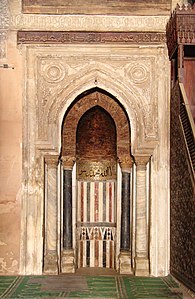
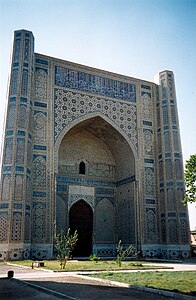
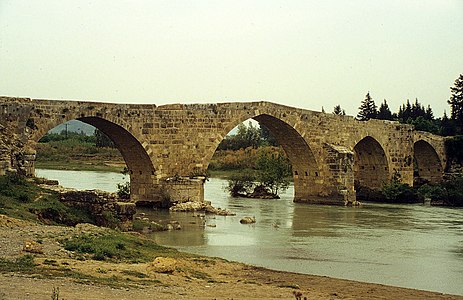
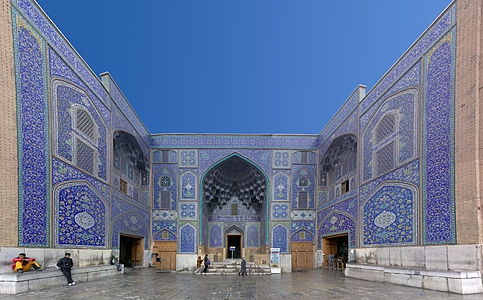
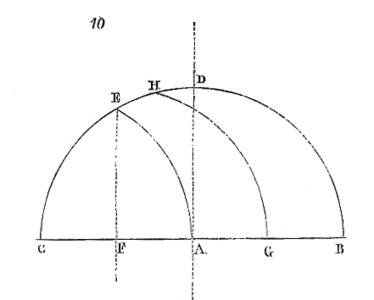



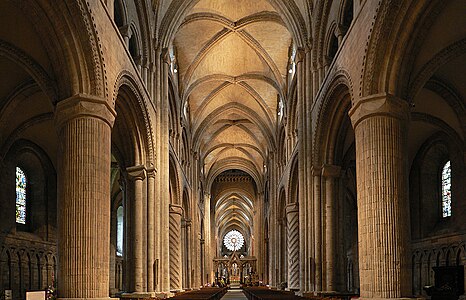








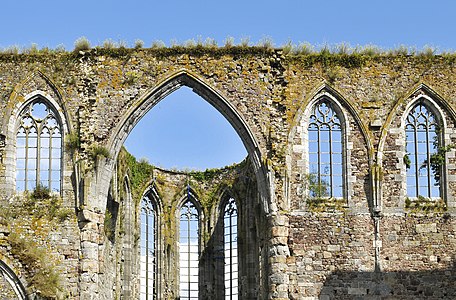
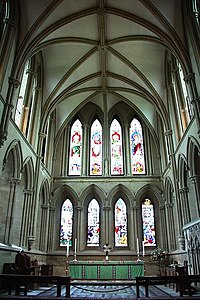
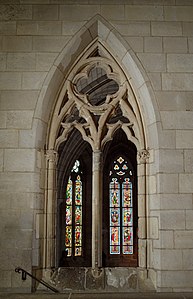
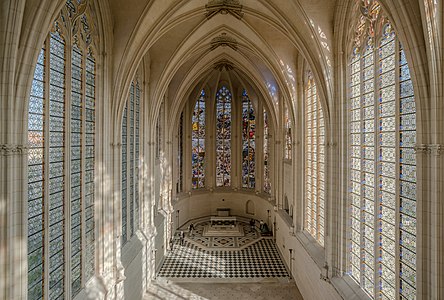


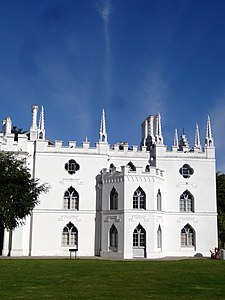

![New Peterhof railway station [ru], Peterhof, Russia (1857)](https://upload.wikimedia.org/wikipedia/commons/thumb/c/ca/%D0%A1%D1%82%D0%B0%D0%BD%D1%86%D0%B8%D1%8F_%D0%9D%D0%BE%D0%B2%D1%8B%D0%B9_%D0%9F%D0%B5%D1%82%D0%B5%D1%80%D0%B3%D0%BE%D1%84_-1.jpg/450px-%D0%A1%D1%82%D0%B0%D0%BD%D1%86%D0%B8%D1%8F_%D0%9D%D0%BE%D0%B2%D1%8B%D0%B9_%D0%9F%D0%B5%D1%82%D0%B5%D1%80%D0%B3%D0%BE%D1%84_-1.jpg)
